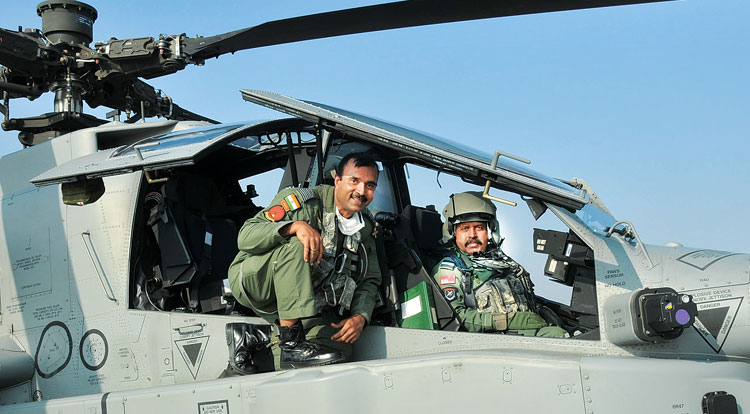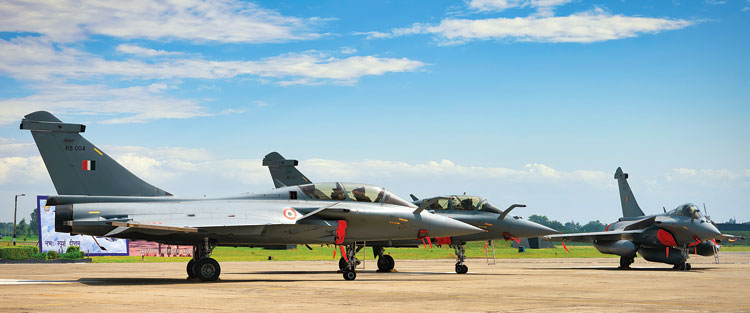INDIAN ARMED FORCES CHIEFS ON OUR RELENTLESS AND FOCUSED PUBLISHING EFFORTS

The insightful articles, inspiring narrations and analytical perspectives presented by the Editorial Team, establish an alluring connect with the reader. My compliments and best wishes to SP Guide Publications.

"Over the past 60 years, the growth of SP Guide Publications has mirrored the rising stature of Indian Navy. Its well-researched and informative magazines on Defence and Aerospace sector have served to shape an educated opinion of our military personnel, policy makers and the public alike. I wish SP's Publication team continued success, fair winds and following seas in all future endeavour!"

Since, its inception in 1964, SP Guide Publications has consistently demonstrated commitment to high-quality journalism in the aerospace and defence sectors, earning a well-deserved reputation as Asia's largest media house in this domain. I wish SP Guide Publications continued success in its pursuit of excellence.
The Indian Air Force in Transition
In the era of the bi-polar world, as India was close to the Soviet Union, the IAF had a dominating presence of Russian aircraft including fighters, transports and helicopters

In 1964 the MiG-21, the first supersonic combat jet that was procured for the Indian Air Force (IAF), was from the Soviet Union. Since then, the IAF remained heavily dependent the Soviet Union for the supply military aircraft and helicopters. Prior to this, the IAF procured combat jets from Western countries which included the de Havilland Vampire, the Folland Gnat, the Hawker Hunter, the English Electric Canberra – all from Britain, the Ouragan (renamed as Toofani in India) and the Mystere from Dassault Aviation of France. In addition, the IAF received the first Anglo-French combat platform, SEPECAT Jaguar in 1979 and the Dassault Mirage 2000 in the mid 1980s. Except for the Jaguar and the Mirage 2000 that continue to be in service with the IAF today, all other combat platforms listed above have been retired from service. The six squadrons of Jaguar are practically on the last leg and would be retired from service in a decade or so.
In the era of the bi-polar world during which India was closer to the Soviet Union, the IAF soon had a dominating presence of Russian aircraft including fighters, transports and helicopters on its inventory. Apart from the MiG-21 variants, the fighter fleet of the IAF inducted the MiG-23, MiG-25, MiG-27, MiG-29, Su-7 and the Su-30 MKI. Of these the MiG-21 Bison, MiG-29 and the Su-30 MKI continue in service today. The MiG-21 Bison fleet however, is expected to be retired from service in the next five years. That will leave three squadrons of MiG-29 and 15 squadrons for Su-30 MKI in service with the IAF.
With the end of the cold war era and the emergence of a uni-polar world, the IAF felt unshackled from Russia and began to explore other options to build up the strength of the combat fleet that had dwindled considerably with the retirement of the older fleets acquired from both the West and the Soviet Union. At this point in time, the IAF saw the opportunity to transit from being confined to the traditional source Russia and explore other options available in the world. Unshackled from the traditional source Russia, the IAF initiated a proposal in 2002 to acquire 126 medium multi-role combat aircraft (MMRCA) for which a global tender was issued in August 2007 to all the major aerospace and defence companies across the globe. From among the six combat platforms in the race for the tender, the IAF selected the Rafale, a 4.5 generation combat jet from Dassault Aviation of France. As per the terms of the contract, 18 aircraft were to be supplied in fly away condition by the original equipment manufacturer (OEM) and the remaining 108 would have to be manufactured in India by the Indian aerospace major Hindustan Aeronautics Limited (HAL) in collaboration with the OEM. Unfortunately, the contract negotiations encountered some insurmountable impediments related to warranty by the OEM in respect of the 108 platforms to be manufactured in India. On account of this issue, the project encountered a logjam and was finally cancelled in 2015. This came as a major blow to the effort by the IAF at transition through the acquisition of a modern combat platform from Western sources rather than to remain dependent on Russia alone.
As per plans of the Indian aerospace industry, the IAF will be assisted in transiting to the LCA Mk II and thereafter to the Advanced Medium Combat Aircraft
As a stop-gap arrangement, the government arranged direct purchase of 36 Rafale jets from Dassault to equip two squadrons. Delivery of Rafale jets have commenced and it is expected that all 36 aircraft to equip two squadrons should be with the IAF by early next year. This can be regarded a success at transition, albeit minor. Having realised that it would be necessary for India to become self reliant in the aerospace industry to enable the IAF to build up the strength of the combat fleet to the authorised level of 42 squadrons from its present strength of 32, the government is taking appropriate steps to help the Indian aerospace industry deliver. On January 13 this year, the government cleared a proposal for HAL to manufacture 83 light combat aircraft (LCA) Tejas Mk 1A for the IAF. Valued art 48,000 crore, this is the largest order for combat aircraft placed on the HAL by the IAF. This indeed has been a major step forward to help the IAF transit to reliance on indigenous production of combat platforms instead of procurement from foreign sources. As per plans of the Indian aerospace industry, the IAF will be assisted in transiting to the LCA Mk II and thereafter to the Advanced Medium Combat Aircraft (AMCA), a fifth generation combat platform that is expected to go into production by 2030.

TRANSPORT FLEET
As has been the case with the combat fleet wherein the IAF is beginning to transit from the traditional source of procurement to another, though at a painfully tardy pace, the experience has been somewhat similar with then transport fleet. Ageing fleets of C-47 Dakota, Caribou, C119 Fairchild Packet and the HS-748 Avro, all from Western sources, were replaced by An-12, An-32 and IL-76, all from the Soviet Union. However, with the freedom to look for sources other than Russia, the IAF managed to procure the most reputed platforms from the United States namely the Lockheed Martin C-130 Super Hercules tactical transport aircraft and the Boeing C-17 Globemaster III heavy-lift aircraft. This has been transition for the transport fleet of the IAF in the real sense. A programme is underway to replace the fleet of Avro aircraft with the Airbus C295 to be manufactured in India by HAL.
HELICOPTER FLEET
Like the combat fleet, bulk of the helicopter fleet consisting of the Mi-4, Mi-8 and Mi-17 transport helicopters, the Mi-26 heavy-lift helicopter and the Mi-25 and Mi-35 attack helicopters have all been procured from the Soviet Union/Russia. Of these, only the Mi-17 helicopters are in service in sizeable numbers. The Mi-25 attack helicopters has been retired from service and of the Mi-35 fleet, only a few remain in service. To add muscle to the helicopter fleet, in March 2019, the IAF began to receive the CH-47 Chinook heavy lift platform of which a total of 15 have been ordered. In addition, the IAF has ordered 22 AH-64E(I) Apache attack helicopter that began arriving in September 2019. With both these platforms supplied by Boeing, the helicopter fleet of the IAF is witnessing a real transition in operational capability.





